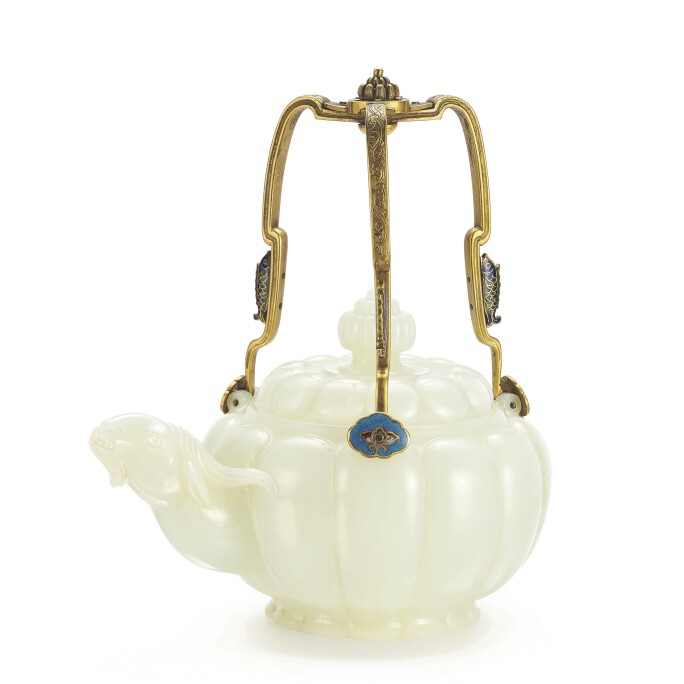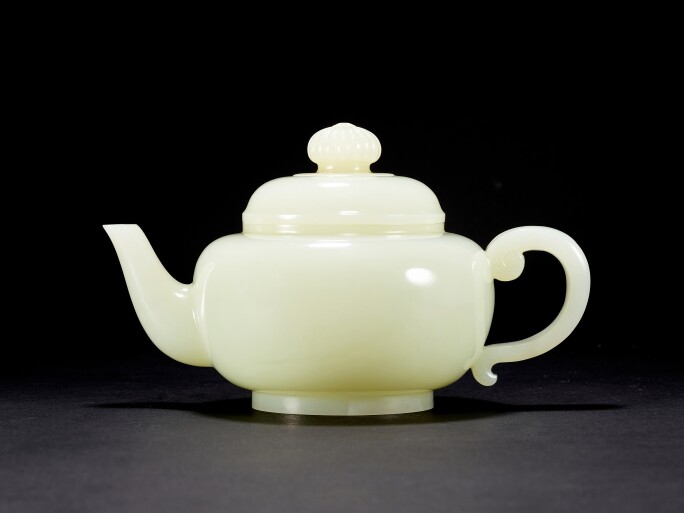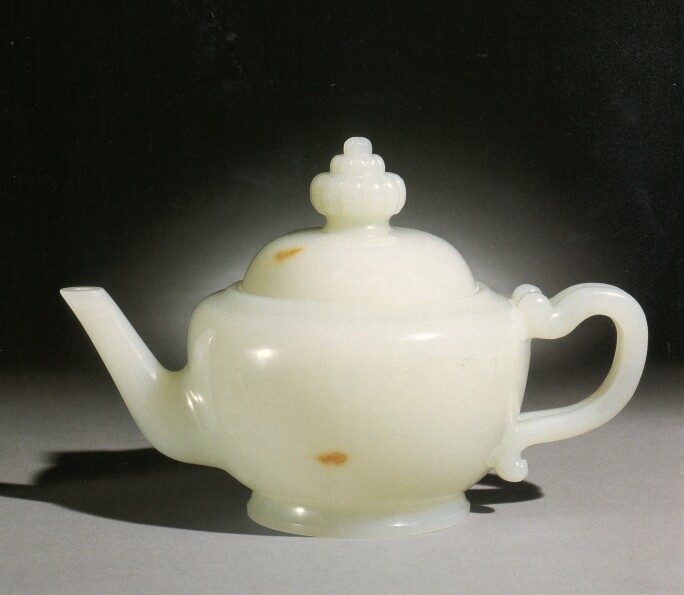Exquisitely articulated from lustrous white jade of the most superlative quality, the ovoid ewer is ingeniously worked in the stylised form of a lotus flower with well-proportioned lobes gracefully surmounted by the delicately carved bud-form finial, subtly tapering down from the shoulder to the ruffled foot, altogether heightening the streamline of the body. Masterfully and scrupulously carved with utmost precision, the cover rests atop the vessel almost seamlessly, coming as one. The C-shaped handle also cleverly disguises itself as a lotus branch, daintily embellished with bifurcated and spiral leaves, attached to the body with a scrolling tip at the lower end, further adding to the overall rhythmicity. The elegance emanated by the spheroid shape renders the present immaculate ewer a true rarity.

A white jade and cloisonne enamel ram-head teapot and cover, Qing dynasty, Qianlong period
Sotheby's Hong Kong, 3rd Octoer 2017, lot 3613
圖一
清乾隆 白玉瓜棱式羊首掐絲琺瑯提樑茶壺
香港蘇富比2017年10月3日,編號3613
The origin of this form of ewers, with a spout and a handle, can be traced to Song ceramics, but most of the extant jade examples are magnificent works from the Ming and Qing dynasties. Ewers with tall and large vessel bodies, often attached with handles above, prevailed during the Ming dynasty with a few exceptions that come with round and wide bodies and lowered handles, possibly influenced by ceramic teapots, which take on a diverse range of shapes from lotus blossom and flower petals to square and round. The quality of the Ming ewers is inferior to the Qing ones in general, despite the rich array of forms offered, in part due to the raw jade available being of lesser quality and the small amount of high-quality jade yielded in Khotan jade mines. During the Qing dynasty, both the development of forms and the quality of materials surpassed the preceding reign, ewers primarily carved from white and celadon jade, and occasionally of green and spinach jade.
Due to the relatively small tapered mouth to the large body, it is much more technically demanding and inconvenient to hollow out ewers of this type than other vessels, not to mention the lengthy and painstaking process of sculpting the spout and handle, as well as the large amount of raw jade required. This accounts for they there was such a limited amount of jade ewers. The development of jade art reached an unprecedented zenith during the Qianlong period under the rule of the jade enthusiast the Qianlong Emperor, who provided immense support to the specialists that later became more experienced and skilful in mining and carving, producing an abundance of jade masterpieces, particularly those intended for imperial use. Both practical and decorative for interior spaces, incense burners, vases, boxes, ewers, bowls, washers, and parfumiers predominated jade vessels of the period, whereas jade ewers remained limited due to the high degree of sophistication required for craftsmanship and the shortage of high-quality raw jade. The Palace Museum, Beijing, for instance, contains a vast collection of fine jade vessels, yet only comprises about a hundred ewers with spouts, roughly divided equally between Ming and Qing periods, according to Xu Lin.
Jade ewers are rare, but the use of white jade of such high purity and quality makes it even more precious. If the stone comes with natural defects, the Qing Imperial Palace workshop would proceed with russet enhancement, or intentionally carve intricate motifs, to cover the natural flaws in the stone. Naturally even and satiny, it is therefore needless for the artisans to carry out excessive ornamentation on the present ewer. Embellished only with petals on the body, the use of simple geometry can already underscore the beauty of the original colour of the jade authentically and sufficiently, shining bright with distinguishable light and shadow divisions when placed under sunlight. Silky and alluring, the present ewer is ideal for both practical and decorative purposes, undoubtedly a paragon of imperial jade.
From the Kangxi to early Qianlong reigns, the jade-producing regions of Khotan and Yarkent were occupied by the Dzungars who blocked major trade routes. The imperial court was therefore forced to resort to either recarving jades from former dynasties or using raw jade sent as tribute or smuggled into the Palace workshop, demonstrating the short supply of jade then. In the 10th year of his reign (1732), the Yongzheng Emperor ordered his ministers to “find some good raw jades” as the court lacked them. Later in the 24th year of the Qianlong reign (1759), the Qing army conquered the Dzungar Khanate definitively and cemented its rule of what is now called Xinjiang, administering it through a regional government. Beginning in the next year, the four sub-Khanates of Xinjiang began to send raw jades to Beijing, which later developed into a formal system of biannual tribute of 4000 jin of raw jade, once in spring and once in autumn. In fact, the tributary system culminated in 300,000 jin of raw jades per annum at its peak. The sheer quality of the white jade stone used for this immaculate ewer clearly points to it having been sourced from one of the tributes.

A white Jade teapot and cover, Qing dynasty, Qianlong period, formerly in the collection of Hinton Daniell Stewart (1835-1926), 6th Laird of Strathgarry
圖二
清乾隆 白玉光素菊花鈕茶壺
Laird of Strathgarry 六世 Hinton Daniell Stewart(1835-1926年)舊藏
As per the records of the workshops of the Qing imperial court, jade ewers were already produced in the first year of the Yongzheng reign (1723), mostly limited to restoring ewers remaining from previous reigns, still, fewer than thirty jade ewers were made or restored during the entire period, according to Xu Lin. As documented, the production of jade ewers saw an evident rise during the Qianlong reign, including those with handles attached. Their features were, however, described too vaguely to find a match with the surviving vessels. A closely related white jade ‘lotus’ ewer, presented by the Viceroy of Min-Zhe Yang Tingzhang, is recorded to have been produced in the 29th year of the Qianlong reign (1764). Another similar white jade ‘lotus’ wine ewer is mentioned in the 35th year of Qianlong reign (1770) archive, but with a flake to its mouth, clearly ruling out the possibility of being the present piece.
Despite checking carefully in the Qing court inventory, the number of jade ewers was extremely limited, corroborating the difficulty in conjuring a fine jade ewer. Among the rare recorded examples are one green jade ‘lotus’ covered ewer (with chips and fissures) preserved in the Western Warmth Chamber, and a celadon jade ‘melon’ covered ewer in the Hall of Mental Cultivation.
Impeccably worked from high-quality white jade with a warm and fine texture, the sensual elliptical body subtly incorporates smooth rounded contours and is so cleverly modelled from an elegantly formed lotus flower, translucent and sophisticated. There are scarcely any ewers of comparable quality in any other private collections. In reference to two Qianlong white jade melon-shaped ewers with a ram-head spout of superior quality and immaculately polished, see one now preserved in the Palace Museum, Beijing, published in The Complete Collection of Treasure of the Palace Museum: Jadeware (III), Hong Kong, 1995,pl. 216, and the other from the collection of Millicent Rogers, the American socialite and close friend of Madame Soong Mei-ling, sold at Christie’s Hong Kong on 28th April 1996, lot 2, and again in these rooms on 3rd October 2017, lot 1613 (fig. 1), for HK$75.5 million, a world-record price for a Chinese jade vessel. See also another similar ram-head ewer, the base engraved with a four-character Jiaqing yuyong mark, characterised by russet enhancements deliberately created in the Imperial Palace Workshops to cover natural flaws in the stone, from the collection of Sir John Woolf, illustrated in The Woolf Collection of Chinese Jades, Sotheby’s, London, 2013, cat. no. 59.
Likewise, a Qianlong white jade ewer with a chrysanthemum-shaped finial, originally in the collection of the Scottish aristocrat Hinton Daniell Stewart, the 6th Laird of Strathgarry (1835-1926), appears translucent and even so effortlessly but heavenly, only the handle embellished with echoing scrolling tips at the beginning and end (fig. 2). Another white jade ewer similarly surmounted by a chrysanthemum-shaped finial, in which parts of it demonstrate russet enhancements to the surface, was sold in these rooms, 31st October 2004, lot 233 (fig. 3), for what was then an unprecedented sum of HK$6.8 million. In a more angular form, another example of a fine white jade ewer was sold in these rooms, 16th November 1989, lot 612.
此壺選取上乘玉材,透亮勻淨、溫潤如脂。妙以寶蓮為題,壺身上微曲、下漸歛,豐盈婀娜,琢出瓣葉片片,自寬肩內束,延至壺鈕,又綻成苞蕾一朵,小瓣拱之,尤為可愛。口與蓋相接之處,合攏完美,猶如天造地設,一絲不苟。壺柄巧作蓮枝,配綴分岔捲葉,極具動感,饒富雅趣。其圓潤柔美、細膩無瑕,在私人珍藏玉壺中尤為罕見,誠屬稀珍。
此類有流及柄的玉執壺,形可上溯宋代陶瓷,但傳世玉例多屬明清之物。明代壺身高大,執柄常置於壺腹之上,但偶有扁圓鼓腹、執柄下移之例,或受陶瓷茶壺影響,且造形不一,如蓮式,花瓣、方壺、圓壺等,紋飾多樣,惟玉質欠佳,反映明代和闐地區玉料開採雖增,但品質多遜清玉。清代玉執壺造形更見豐富,玉質明顯優於前朝,多採白玉及青白玉,但也有青玉、碧玉等茶壺傳世。
此式茶壺因其口小腹大,掏膛工藝較一般器皿更為複雜,還要琢出流及柄,耗時費料,因此數量受限。乾隆年間,玉雕工藝發展已臻成熟,除玉料開採外,雕琢技術精益求精,加上匠人豐富經驗,以及乾隆皇帝的大力推動,促使玉雕藝術問鼎巔峰,所出玉器精妙者眾,特別是宮廷陳設用玉,至今仍難以企及。然而緃觀各式陳設器皿,雖多見爐、瓶、盒、洗等,美觀實用,但礙於雕琢繁複,較諸他類,執壺為數仍稀。以北京故宮博物院明清藏品為例,玉器非寡,但據徐琳統計,附流執壺僅只百餘件,兩朝各約佔半。
玉壺已罕,玉料如此溫潤潔白者更稀。清宮造處玉作,因材施藝,石質欠佳者,多加以烤皮染色,甚或以繁紋縟飾,掩瑕避綹。此壺石質勻淨亮白,是以匠人在壺身僅琢瓣葉,以簡潔線條彰顯玉料原色,置於煦光日下,明暗分明。遠觀柔美,近撫絲滑,陳設既適,實用兼宜,誠屬清宮御製玉器臻絕之例。

A white jade teapot and cover, Qing dynasty, Qianlong period
Sotheby's Hong Kong, 31st October 2004, lot 233
圖三
清乾隆 白玉光素菊花鈕茶壺
香港蘇富比2004年10月31日,編號233
從康熙到乾隆朝前期,出產美玉的和闐、葉爾羌地區被準噶爾部佔領,西北往來不暢,玉路不通,宮廷用玉或要改製前朝舊玉,或靠進貢與走私玉料,故製作有限。雍正十年(1732年)世宗還命大臣:「將好玉材料尋些送來」,說明宮廷玉料不足。乾隆二十四年(1759年),清軍攻克準噶爾部,鞏固了西北邊疆的統治,設置官府,將新疆地區納入中央政府的統一管轄。翌年始,四部玉貢進京,形成正式的貢玉制度,年例供玉四千斤,分春秋兩季,但實際最盛之時清廷每年收進三十萬斤玉料。本品玉質淨白無瑕,細緻溫潤,應為大量玉料中千挑萬選之材。
據《清宮內務府造辦處活計檔案》,雍正元年(1723年)已有玉壺製作,惟多乃收拾前朝遺留舊壺,據徐琳研究,整朝總共收拾前代及當朝所製玉壺不足三十。到了乾隆時期,據檔玉壺製作數量較前顯著增多,當中也有帶柄執壺的記載,但特徵模糊,難與實物對應。相關記錄有如乾隆二十九年(1764年),閩浙總督楊廷璋進貢「白玉蓮花壺一件」。乾隆三十五年(1770年),又有製「白玉蓮花酒壺一件」,但其口有磕,絕非本器。
觀清宮陳設檔案,雖有錄玉壺,卻甚稀,佐證其製作之艱。光緒年間檔案載西暖閣貯「青玉蓮花式有蓋壺壹件(有缺有綹)」,養心殿又存「青白玉瓜瓞有蓋執壺一件」。
此壺以上等白玉琢成,玉質細膩溫潤,幾近無瑕,線條柔弧簡練,妙採寶蓮為題,晶透雅緻,私人收藏可與之媲美者極罕。參考兩把乾隆白玉羊首瓜式提梁茶壺,其玉質潔美、打磨細膩,其中一器現藏北京故宮博物院,載於《故宮博物院藏文物珍品全集.玉器(下)》,香港,1995年,圖版216;另一把壺則為美國名媛米莉森.羅傑斯(Millicent Rogers)收藏,羅氏為宋美齡摯友,售於香港佳士得1996年4月28日,編號2,及香港蘇富比2017年10月3日,編號3613(圖一),以75,475,000港幣成交,刷新中國玉雕世界紀錄。同式羊首壺,尚有一把,底署「嘉慶御用」款,一側顯見造辦處玉匠刻意烤皮以掩瑕綹,該壺屬約翰.伍夫爵士(Sir John Woolf)舊藏,錄於《伍夫收藏中國玉器》,蘇富比,倫敦,2013年,編號59。
上乘白玉茶壺,尚有他例,如蘇格蘭棉業大亨 Laird of Strathgarry 六世 Hinton Daniell Stewart(1835-1926年)舊藏乾隆白玉菊鈕茶壺,壺身光素,柄綴弦紋,玉質勻淨亮白(圖二)。另有一把白玉菊鈕壺,局部稍作染色,2004年10月31日售於香港蘇富比,編號233(圖三),成交價約680萬港幣,為當時前所未見之高價。還可參考香港蘇富比1989年11月16日,編號612,造形更見方正。